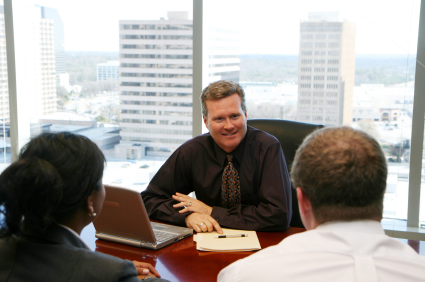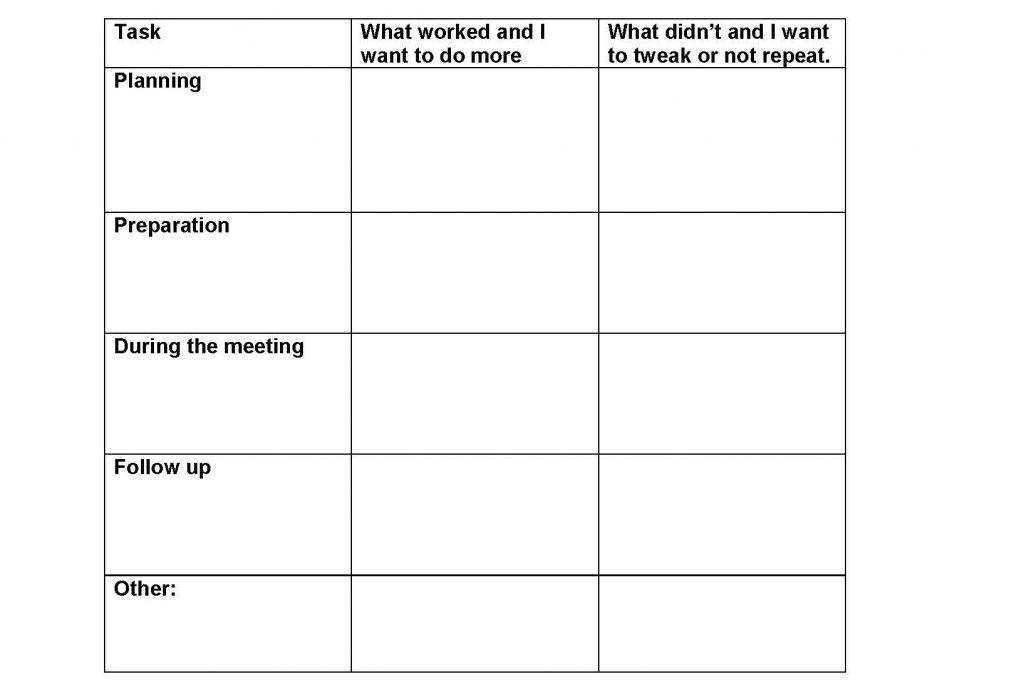Executing the meeting is where it all comes together – all of the careful planning, all of the meticulous preparation. These foundations are important, but how you handle the meeting will build upon them – and if you don’t execute the meeting effectively, the whole thing can collapse!
In this blog, I will help you to stop that from happening, exploring how to carry out your meeting in a way that takes strength from your preparation work. Then, after your colleagues have been dazzled by your meeting’s brilliance, you can take the right follow-up action to wring the maximum benefit from the meeting in its aftermath.
If you haven’t read my blog on planning and preparing yet, I strongly recommend that you do so, as both that blog and this one are part of a mini-series on making your team meetings work for you. The series looks like this:
- Planning and preparing the meeting
- Executing the meeting and following-up ⇐(You Are Here!)
- Dealing with difficult behaviours in meetings
And, if you are wondering why anyone would go to so much trouble for a ‘pointless’ team meeting, you can read my blog on ‘What is the point of your team meetings?’
Executing the meeting
1. Get there early
I don’t know if you have noticed, but being late is endemic in the legal profession! So why not be different?
Joking aside, you should try to arrive at the meeting five to ten minutes early. This sets the right tone for the meeting from the outset; in essence, it indicates you believe your meeting is a good use of time and that others should also treat it as such. You need to lead from the front on this, as turning up late may suggest you are not really invested in the meeting; it could even be seen as a lack of respect for the other attendees.
Arriving early also allows you to do a final check that everything is ready for an effective meeting. This might include checking:
- The environment is right for the meeting, i.e. no loud background noise or other distractions.
- The furniture is arranged correctly.
- The right materials are present, such as pads, pens, whiteboards, projectors etc.
- Appropriate refreshments are available, such as water jugs, glasses, tea, coffee, biscuits etc.
- Any technology you will be relying upon is working, for example, laptops, PowerPoint presentations, video conferencing equipment etc.
2. Starting your meeting

A strong start is useful for setting the right expectations for your meeting. It can focus everyone on the meeting’s purpose and set the right tone. An uncertain, ‘woolly’ start to a meeting is only likely to make everyone expect they are in for a waste of time.
There is no single right way in which to start a meeting. A lot will depend on the type of meeting you have arranged and the objectives you and your team intend to achieve. For example, where someone else will be acting as chairperson for the meeting, you may wish to introduce them, or they might want to start the meeting themselves. Ideally, you should arrange this with the chairperson to avoid any confusion at the start of your meeting.
For any meeting, a good start is to identify and introduce the purpose of the meeting and the intended outcomes. Additionally, it may be useful to give the attendees an idea of the format of the meeting. For example, if there is to be a presentation, you may wish to indicate how and when the other attendees can ask questions – perhaps throughout or only at the end? Outlining the format of your meeting is especially important if you are trying to introduce a new format, or if this particular meeting will be different from the norm. This may seem obvious, but it is easy to overlook when we know what is planned for our meeting. The attendees won’t necessarily know what to expect, and giving them some indication can make them feel more comfortable about the coming meeting.
3. During the meeting
It is important to always keep in mind that meetings fail when they do not result in action. There are a few ways you keep the meeting’s emphasis on taking action:
- Ask questions which are action-focused, such as: what should or must be done? What is the next step?
- When you get to the end of each agenda item, summarise the action, which has been agreed upon. It is also helpful to summarise all actions for each item again at the end of the meeting, especially if a lot of tasks have been divided between the attendees.
- With exploratory meetings, suggest next steps, which each attendee could take to make progress with an objective.
- Record the action agreed upon during the meeting (see below). This can also help you to keep track of the meeting’s progress through its agenda.
You should always try to keep the meeting progressing through its agenda. Where you have prepared a schedule beforehand, stick to it wherever possible. Not only does this prevent the meeting from getting bogged down and losing direction, it gives you the best chance of deciding action for all of the items on your agenda. Perhaps less obviously, keeping to your schedule will allow you to end your meeting properly (more on this below).
4. Keeping records in the meeting
It can be very helpful to have your own notes and records for a meeting. Often, a simple form is all that’s needed to record the actions which have been agreed upon.
The table below gives an example of how you might do this, although you may prefer to create your own variation. A table like this will provide you with a clear way of recording the further action needed, who is to carry it out, and when it needs to be completed:

You might also choose to record the actual discussions, as a way of keeping them fresh in your memory, or so that the action points can be easily picked up by others. If so, it is simply a case of adding an extra section to your table.
5. Bringing the meeting to a close
Ending a meeting may seem like an easy task – you simply thank everyone for coming and go back to your desk, right? Not exactly. In fact, how you end the meeting can be almost as important as the content of the meeting itself.
The end of a meeting can be used to help with action after the meeting and also with your own follow-up. You and the other attendees will have put a lot of time and effort into the meeting at this stage. Ending the meeting strongly can increase the chances of this being worthwhile.
So, before signalling that the attendees can leave, here are a few steps to consider, depending on the nature of the meeting:
- Allow five to ten minutes for questions or discussion of the agenda and intended action. Use open questions (i.e. those which allow for more than a short answer like ‘yes’ or ‘no’) to make sure that everyone has understood the purpose and content of the meeting. If it’s a recurring meeting, you can also use this time to request topic suggestions for the next meeting.
- Summarise the key decisions made throughout the meeting. If there are still items which are undecided, you can try to resolve them now, perhaps by putting them to a vote.
- Where attendees have agreed action points to complete within a certain time frame – ask them what they think would help or hinder its achievement, as a way of gauging the strength of their agreement. Sometimes it is easy for people to feel pressurised or get carried away in a meeting, agreeing to action points which are unrealistic. This ‘reality’ check can flush these issues out and they can be dealt with now instead of becoming a problem down the line.
- Ensure that your documentation has a record of the decisions made and the action points agreed upon.
Following-up after the meeting
After the meeting has concluded, there are a number of opportunities for taking full advantage of the work done in the meeting.
The first step is to draft the minutes, or other records of what the meeting achieved and what was agreed upon. When you distribute the minutes to the attendees, it will act as a good reminder of what was discussed, and the action which is required of them following the meeting.
You should also deal with any action points which are for you to resolve, working on them and diarising as necessary.
These are the more obvious follow-up actions. However, the aftermath of a meeting also allows you to evaluate the meeting itself, examining what you can learn from it.
 Was the meeting a success?
Was the meeting a success?
Perhaps the first question you should ask yourself is whether the meeting was successful. This will lead you to consider many different aspects of the meeting. Some questions you might choose to think about are:
-
-
-
-
-
- Did the meeting fulfil its purposes?
-
- Was the meeting held on the best day and at the best time to achieve a satisfactory outcome?
- Did it start and finish on time?
- Were the correct people in attendance?
- Was the agenda followed in the correct order? Or was the team’s contribution more important?
- Were accurate notes taken?
- Were the necessary decisions made?
- What would you change for next time?
-
-
-
Analysing the bad points as well as good ones will help you to get a balanced picture, and can then be used to assist with planning meetings in future. The table below is a useful way to record your thoughts on this:

Asking for feedback from attendees
If you are brave enough, you might ask the attendees how they think the meeting went as soon as it finishes. It is best to keep this simple and conversational by asking only a couple of questions, such as:
- What did they enjoy or find useful about the meeting? In other words, what parts of the meeting would they like to keep for future meetings?
- What parts of the meeting, if any, would they like to change for next time?
Formal, written feedback
If asking attendees for feedback at the end of the meeting sounds too intense, then try giving them a questionnaire to take home. This can lead to feedback which is perhaps more honest and detailed than that which you might receive face-to-face. Here are some sample questions you could include on the questionnaire:
- Did you enjoy the meeting?
- Did you understand the objectives of the meeting?
- In your opinion, were those objectives achieved?
- Did you feel you were given enough opportunity to contribute?
- Were you told about the meeting early enough?
- Was the meeting arranged at a time to suit your commitments?
- Was the meeting held at a convenient location for you?
- Have you taken any follow-up action agreed at the meeting?
The feedback you gather can be invaluable in planning future meetings, especially when combined with your own reflections on how the meeting went.
In my next blog, I will be looking at the nightmare situations – the difficult behaviours which can disrupt even the most carefully planned meeting! I will be sharing techniques to arm yourself against these challenges, allowing your meetings to be not just effective, but resilient to potential setbacks.
If having effective meetings is something that you are struggling with at the moment – losing time, money and energy in meetings, which achieve nothing – then coaching, may be the answer for you.
Or perhaps you need your team to work better together? If so, then your team could benefit from a 2-hour group workshop on‘How to be effective in team meetings’, ensuring you and your team can maximise the value of your meetings. Telephone me for a friendly, no-pressure chat on 07921540039 to discuss further.
YCFL delivers strategic coaching, leadership, management and interpersonal skills training for the legal profession. Since 2003 Ann has trained nearly 7000 lawyers in leadership, management, business and interpersonal skills. She has also trained with the Coaching Academy and holds a H.N.L.P. certificate in coaching as well as being an N.L.P. Master Practitioner. She is a member of the Professional Speaking Association and Professional Speakers Academy.
